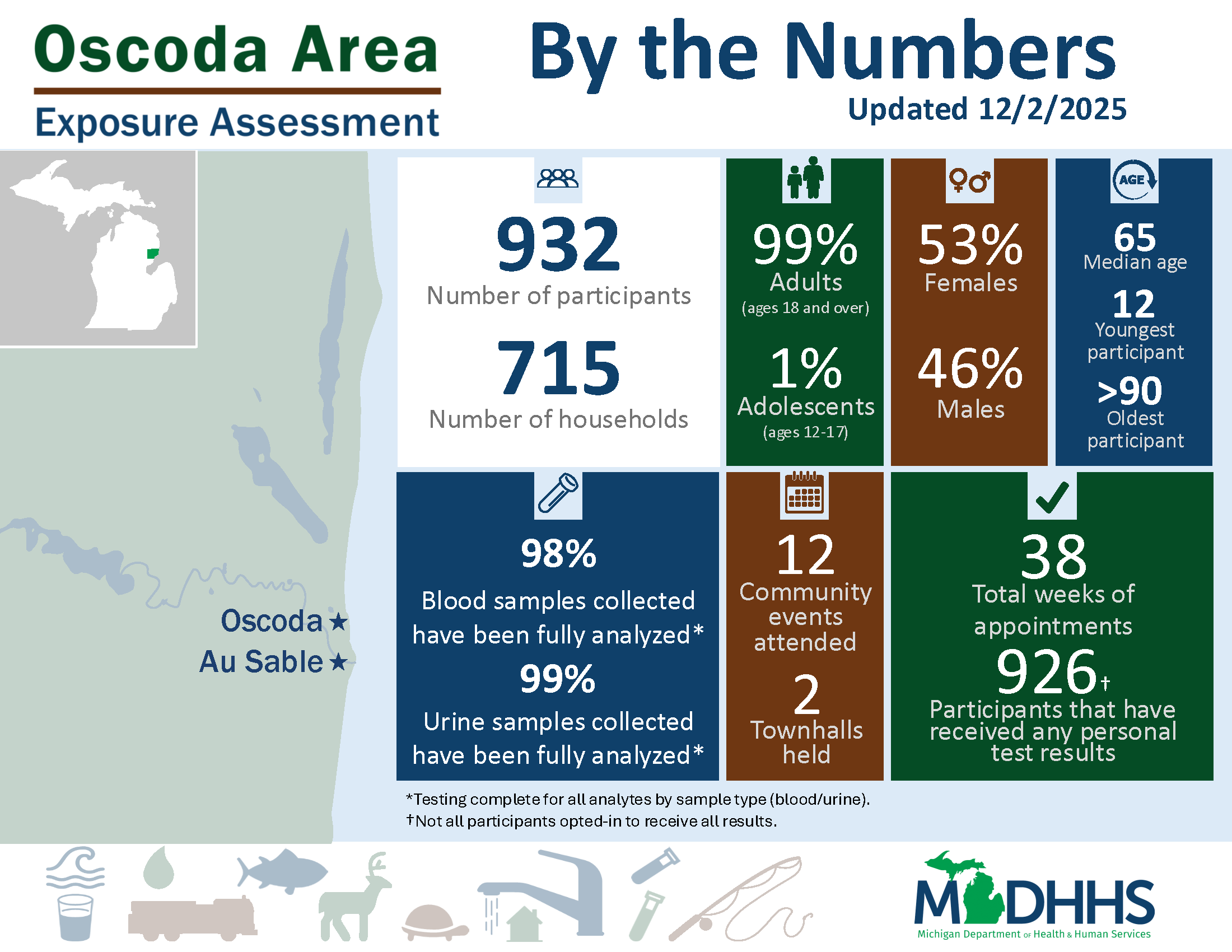The web Browser you are currently using is unsupported, and some features of this site may not work as intended. Please update to a modern browser such as Chrome, Firefox or Edge to experience all features Michigan.gov has to offer.
Oscoda Area Exposure Assessment (OAEA)
Data collection for the Oscoda Area Exposure Assessment (OAEA) ended in December 2024. We estimate that all participants will have all results for the nearly 200 chemicals we are measuring by Winter 2026.
After analyzing participants’ lab results and survey answers, reports will be created summarizing what we learned. These reports will be available to the public online.
MDHHS’s OAEA project was an investigation of exposure to certain chemicals in the blood and urine of residents of the Oscoda area, including mercury, PCBs and PFAS.
If you have any questions about the project, please call 844-464-7327, between 9 a.m. and 6 p.m., Monday through Friday.
Project Information
People can come in contact with chemicals in what they eat and drink, in products they use, at work and in their environment, like in the air, soil and water. Some chemicals are helpful and necessary for life, and some can be harmful. Either way, this contact with chemicals is called a chemical exposure.
Who was eligible for this project?
Adults (18 years and older) and adolescents (12 to 17 years) who live in either Oscoda or AuSable Township.
Those who were eligible were able to enroll in the project by calling the OAEA team.
Why would people participate in this project?
By participating in this study, participants:
- Learned about their exposure to PFAS.
- Learned about their exposure to other chemicals, such as mercury and PCBs, that can be found in fish throughout the Great Lakes region.
- Were part of Michigan’s PFAS projects.
How did MDHHS conduct this project?
The OAEA was carried out as one part of the Michigan biomonitoring surveillance program named the Michigan Chemical Exposure Monitoring program, or MiChEM. The MiChEM icon (left) was on materials used in the OAEA. To learn more, visit our MiChEM page.
By using MiChEM materials and methods, OAEA:
- Provided adult participants measurements for a total of 191 chemicals, including 39 PFAS, from samples of their blood and urine.
- Provided guardians of adolescent participants with measurements for a total of 39 PFAS from a sample of the adolescent’s blood.
- Was able to compare results to Michigan as a whole. This will help MDHHS identify if OAEA participants have different exposures than other Michigan residents.
The key ways that the OAEA is different than the MiChEM program are:
| OAEA | MiChEM program in other parts of Michigan | |
| Eligibility |
All members of an eligible household who were 12 years or older could participate. There was no limit to the number of eligible people who could participate. |
One randomly selected adult (18 years or older) per eligible household can participate. There is a limit to the number of households in a specific geographic area who can participate. |
| Testing for participants ages 12-17 | Participants aged 12-17 years had a blood sample tested for PFAS. | Those aged 12-17 years are not eligible to participate. |
| Appointment Times | Appointment availability began in 2022 and ended in 2024. | MiChEM is on ongoing program. Appointments will only be available during a short period of time in each selected community. |
For more information, including the list of 191 chemicals that adult samples were tested for in OAEA, visit Michigan Chemical Exposure Monitoring (MiChEM).
What did participants do?
- Participants answered survey questions online or by phone, which took about 30 to 45 minutes. These questions are about how they may have come in contact with certain chemicals.
- Participants attended a 30-minute appointment. During the appointment, a trained professional collected a blood sample and asked for a urine sample. (Participants 12 to 17 years only provided a blood sample for PFAS testing.)
Once participants completed these steps, they received:
- A $65 Visa gift card.
- Personal lab results for the 191 chemicals that we measured in blood and urine samples adult participants gave – a $1,000 value – along with resources on how to reduce chemical exposures. (Participants 12 to 17 years received personal lab results for the 39 PFAS measured in their blood samples.)
Will participants get their lab results?
Yes. Unless participants chose to opt out, results were mailed to their homes. The results told participants the amount of certain chemicals in their blood (and urine, if measured) at the time they were collected. Results will not show:
- The source of any of the chemicals in blood or urine (if measured).
- Anything about any chemicals we did not measure.
- If the chemicals we measure are currently harming their health, have harmed health in the past or may harm health in the future.
MDHHS has resources for doctors and other health professionals.
In February 2021, MDHHS did a presentation about PFAS for doctors and other health professionals who see patients from the Oscoda area. To watch a video of the presentation, go to Per- and Polyfluoroalkyl Substances (PFAS): Information for Oscoda Area Healthcare Providers Webinar.
For more information about MDHHS resources for health care providers about environmental health, please visit Environmental Health Education for Health Care Providers.
Privacy and safety are important to MDHHS.
All samples and information will be stored securely at MDHHS. MDHHS will protect results to the fullest extent allowed by law. MDHHS will not give other parties participants’ data without their written permission.
Any reports or articles about the program will only talk about group results. These reports or articles will not include information that could identify participants, such as their name or contact information.
If you have questions about the Oscoda Area Exposure Assessment (OAEA) project, call 844-464-7327 between 9 a.m. and 6 p.m., Monday through Friday.

